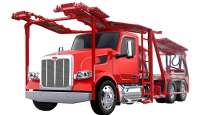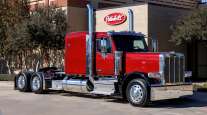Managing Editor, Features and Multimedia
Peterbilt Unveils Electric Medium-Duty Truck at CES
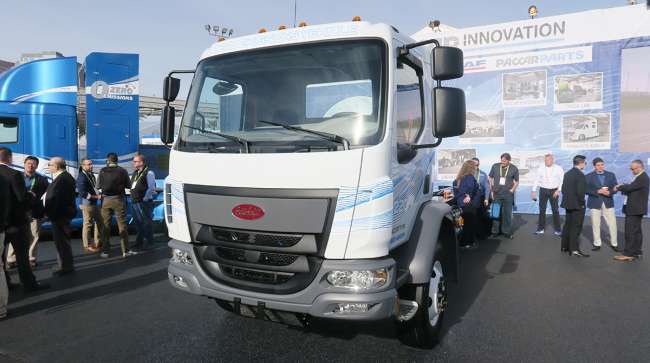
LAS VEGAS — Peterbilt Motors Co. has unveiled an all-electric medium-duty truck, adding a third model to its emerging electric-vehicle lineup.
The truck maker introduced the zero-emissions Model 220EV on Jan. 8 here at CES, the world’s largest technology trade show.
The battery-electric cabover, geared toward local pickup and delivery operations, has a 100-mile range and can recharge in an hour when plugged into a fast-charging system, the manufacturer said.
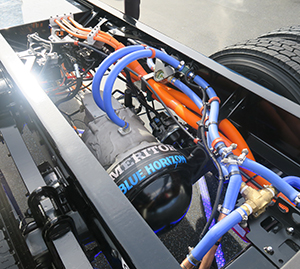
The Peterbilt Model 220EV is powered by an electric motor on its rear axle from Meritor Inc. (Seth Clevenger/Transport Topics)
The medium-duty model joins two other electric trucks introduced by Peterbilt within the past two years: the Model 579EV, a Class 8 tractor for port drayage and regional applications, and the Model 520EV, an electric refuse truck.
With those three vehicles, Peterbilt will have electric trucks that are suitable for a diverse range of shorthaul and regional trucking operations.
“We’ve got refuse covered, we’ve got regional haul covered, and we have inner city and local pickup and delivery covered,” Peterbilt General Manager Jason Skoog said at the event. “At Peterbilt, we think those three applications are going to have the most immediate and near-term payback from a [return on investment] perspective for our customers.”
In addition to the new Model 220EV, Peterbilt showcased a Model 579EV at parent company Paccar Inc.’s outdoor exhibition space in front of the Las Vegas Convention Center.
Peterbilt plans to begin delivering the Model 220EV in the summer. The company said it will place six of the trucks into service this year with an undisclosed customer in the food and beverage sector.

More From CES 2019
Altogether, Peterbilt will have more than 30 electric vehicles on the road by the end of this year with customers in regional haul, refuse and urban delivery applications, the company said.
Customer field trials with Model 579EVs and 520EVs are already underway, and the manufacturer also is conducting validation testing at the Paccar Technical Center in Mount Vernon, Wash.
Scott Newhouse, Peterbilt’s chief engineer, said the Model 220EV was built in collaboration with component supplier Meritor Inc. and TransPower, a provider of electric-vehicle systems.
“It’s designed to perform as well or better than a diesel powertrain truck,” Newhouse said.
Instead of a traditional internal combustion engine, the truck is powered by an electric motor mounted directly on the rear axle.
This Blue Horizon electric drive axle from Meritor offers peak power of 250 kilowatts.
The vehicle’s e-axle configuration opens up space between the frame rails to mount the batteries, Newhouse said.
“All the components are packaged so that the same body that is put on a diesel powertrain vehicle can easily drop right onto this truck with no differences,” he said.
The truck is equipped with two TransPower battery packs for a total storage capacity of 148 kilowatt hours.
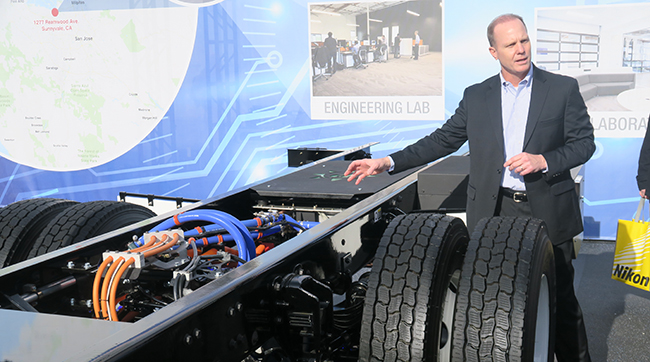
Peterbilt’s Scott Newhouse explains the Model 220EV’s electric propulsion system at the vehicle’s unveiling in Las Vegas. (Seth Clevenger/Transport Topics)
Although Peterbilt has introduced electric truck models and is beginning to put those vehicles in the hands of its fleet customers, the company has not announced a specific timeline for broad commercial availability.
“What we’re focused on is gaining real-world miles in real-world applications,” Skoog said.
The timing for a commercial launch will depend on a variety of factors, including the development of charging infrastructure and customer readiness, he said.
“There are a whole lot of things that have to come together to be successful, and customers have to be willing to commit to paying a higher price at this point,” Skoog said. “These are still very expensive vehicles.”
Right now, grants are helping to defray a lot of that added expense, and some customers will deploy electric trucks to bolster a “green image,” but ultimately, further cost reductions will be needed to enhance the business case, he said.


